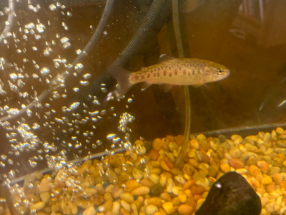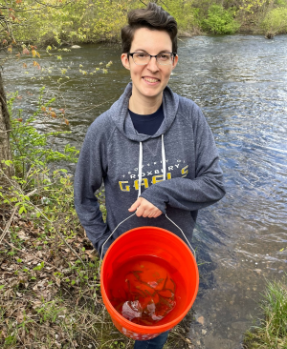- Roxbury Public Schools
- Initiatives
- Trout in the Classroom
Gaels Going Green
Page Navigation
LRS' Trout in the Classroom
-

For a number of years, Lincoln/Roosevelt School has participated in the Trout in the Classroom (TIC) program in partnership with the NJDEP Fish & Wildlife and Trout Unlimited in New Jersey. TIC is a science-based program that teaches children about the importance of coldwater conservation through a hands-on approach to learning. At the beginning of each school year, our LRS students in Ms. Rodgers and Ms. Hallet's class set up tanks in the classrooms where they can interact with the fish daily. Students watch the trout grow from eggs to healthy fingerlings in a tank that mimics their natural habitat. Then, each spring, the classes release the trout into the wild.
Through the process of raising trout from eggs provided by the Pequest Trout Hatchery to fingerling size for release, students learn about the importance of clean, cold water, not only for the trout they are raising, but also for other organisms, including people.
TIC is a program that LRS uses to teach our students about the importance of clean fresh water. Because trout are so sensitive to pollution, it is vital for their survival that they live in an area of high water quality. We discuss with the students the importance of clean water as well as what we can do to ensure our freshwater remains clean. Because we raise the trout from eggs, they also learn about their life cycles and their importance to our local ecosystem.
More than 40,000 students each year in New Jersey discover the importance of clean water through this program. This program connects urban, suburban and rural students in the discovery of the importance of clean water - for insects, trout, for people - clean water is needed by everyone!
For more information on this program, visit NJDEP Fish & Wildlife website.
Releasing the Fish
-

It’s a sad time of year when we have to say goodbye to our little ones, put away the equipment and wait for the new TIC year to begin once again.
Many people wonder why their fingerlings can’t just go into any stream or pond near their school, but if you have just spent the year teaching your students about the values of clean, cold water, why would you just dump them anywhere? The answer is – you wouldn’t!
With the Trout in the Classroom Program, NJ Fish and Wildlife biologists want the fingerlings going into streams where they have a chance of surviving once they have left your care. It’s like having your kids leave home for the first time – you want them to be in a place where you know they have a good chance of making it on their own. That means the fingerlings need to go into the best habitat for them – not the pond down the street.
Streams are classified by Fish and Wildlife biologists based on biological characteristics of the water body. They look at water quality and quantity – is it polluted, silted up, clear and free flowing? What fish and other organisms live in that water body? Are trout present? Are the fish all the same age or are trout reproducing in the water body?
Freshwater (FW) water bodies are classified based on whether they are wholly contained within state, federal or special holding properties (FW1) or if they flow through other areas of the state (FW2). These water ways are then further classified into three categories based on their ability to support trout.
- TP = Trout Production: These waterways have been designated for use by trout for spawning or nursery purposes during their first summer.
TM = Trout Maintenance: These waterways can support trout throughout the year.
NT = Nontrout: These waters fall do not fall into any of the above categories. They are generally not suitable for trout because of their physical, chemical or biological characteristics, but can support other fish species.
Waters can be further classified into Category One Waters (C1) and Category Two Waters (C2). C1 waters are protected from changes to the existing water quality. These waters can be identified by their clarity, color, scenic setting, other characteristics of aesthetic value, exceptional ecological significance, exceptional water supply significance or exceptional fisheries resource. C2 waters are not designated as outstanding quality waters or C1.
Fish raised as part of the Trout in the Classroom program must be released into streams that are classified as Trout Maintenance (TM). They cannot be released into Trout Production streams because we want to keep the wild fish – wild! To release a TIC fish into a non-trout waterway doesn’t make sense after all the hard work we have done raising the fingerlings all year long. Biologists have determined appropriate release sites for TIC fish based on the classification of the waterway, proximity to major roadways, parking areas for buses and other factors.
Each spring, Ms. Hallet and Ms. Rodgers take the fingerlings to a tributary off of the Rockaway River to be released. This area is dictated by the TIC program. Unfortunately, this area is down a very steep hill, so our students are not able to visit the location. But not to worry! Our teachers record a video of the release for the kids.
- TP = Trout Production: These waterways have been designated for use by trout for spawning or nursery purposes during their first summer.

